Invented by the natives of North America, pemmican was used by Indian scouts as well as early western explorers. These people spent a great deal of time on the go and depended on having portable, high-energy, highly nutritious, and filling foods that would last for long periods of time.
Pemmican was light, compact, high in protein, carbohydrates, vitamins, and if done properly can last anywhere from a few years (decades) up to a lifetime without refrigeration!
Pemmican consists of lean, dried meat which is crushed to a powder and mixed with hot, rendered fat. Back in those days the natives made it with bison, deer, or elk but nowadays it is usually made with beef. Crushed, dried berries can be added as well.
A man could subsist entirely on pemmican, drawing on the fat for energy, the protein for strength and vitamins for health. There are a few cases in history of people living for months (in good health) only out of pemmican.
So, it’s easy to understand why I choose pemmican as the ultimate survival-superfood.
People really should avert their gaze from the modern survival thinking for just a bit and also look at how the guys who wandered the west 130 or so years ago did it. As I’ve said it in a recent article (30 Lost Ways of Survival from 1880) the “SHTF” we all prep for is what folks 150 years ago called “daily life:” No electrical power, no refrigerators, no Internet, no computers, no TV, no hyper-active law enforcement, no Safeway or Walmart.
How to Make Pemmican
You’ll need:
- 4 cups lean meat or a pound (deer, beef, caribou or moose)
- 3 cups blueberries (or other dried fruits)
- 2 cups rendered fat (or 1/2 pounds)
- Optional – unsalted nuts and about 1 shot of honey
Get about a pound and a half of lean, grass-fed shoulder roast and let it firm up in the freezer so you can slice it thin.
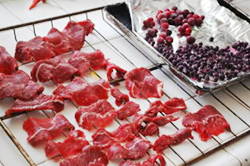 Add salt and pepper. Set the oven to the lowest possible temperature (around 150 degrees) and put the strips of meat directly onto the rack. Crack the oven door to prevent moisture buildup.
Add salt and pepper. Set the oven to the lowest possible temperature (around 150 degrees) and put the strips of meat directly onto the rack. Crack the oven door to prevent moisture buildup.
At this point, you can also put a handful of frozen wild blueberries on a small oven pan to dry out with the meat.
Let the meat dry out for about fifteen hours, or until it is crispy. Toss it in the food processor until it becomes a powder. Do the same with the blueberries. In the old days they’d pound it with a rock to turn it into a “powder”.
For the fat portion of pemmican, you can use tallow (rendered beef or mutton fat) or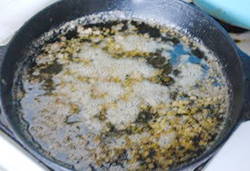 lard (rendered pork fat). Cut up your fat in small pieces and place the fat into the crockpot. Set the crock pot on low heat and remove it only after it becomes completely liquid. Use a strainer to avoid all the crispy bits; you just want the pure, liquid fat.
lard (rendered pork fat). Cut up your fat in small pieces and place the fat into the crockpot. Set the crock pot on low heat and remove it only after it becomes completely liquid. Use a strainer to avoid all the crispy bits; you just want the pure, liquid fat.
Mix the meat and berry powder together, then slowly add the hot liquid fat. Pour 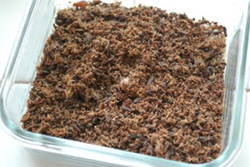 just enough so that the fat soaks into the powder – slowly.
just enough so that the fat soaks into the powder – slowly.
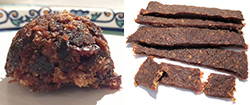 Let it firm up, then cut it into squares or roll it into a ball.
Let it firm up, then cut it into squares or roll it into a ball.
If done and stored correctly it can last for decades. Wrap these “pemmican balls” in wax paper and store them in a ziplock bag in a cool, dark place.
Back in the 1800, the native people Canada (Metis) would go southwest onto the prairie, slaughter buffalo, convert it into pemmican and carry it north to trade at the North West Company posts. For these people on the edge of the prairie the pemmican trade was as important a source of trade goods as was the fur trade for the Indians further north. And this is because for a serious journey, almost all foods would have been too heavy to carry.
If you’ll ever have to bug out – especially without a car – keep this in mind: Pemmican is the most compact, light, natural and nutritious supply you can take with you.
Source: askaprepper.com
Here’s just a glimpse of what you’ll find in The Lost Ways:
From Ruff Simons, an old west history expert and former deputy, you’ll learn the techniques and methods used by the wise sheriffs from the frontiers to defend an entire village despite being outnumbered and outgunned by gangs of robbers and bandits, and how you can use their wisdom to defend your home against looters when you’ll be surrounded.
Native American ERIK BAINBRIDGE – who took part in the reconstruction of the native village of Kule Loklo in California, will show you how Native Americans build the subterranean roundhouse, an underground house that today will serve you as a storm shelter, a perfectly camouflaged hideout, or a bunker. It can easily shelter three to four families, so how will you feel if, when all hell breaks loose, you’ll be able to call all your loved ones and offer them guidance and shelter? Besides that, the subterranean roundhouse makes an awesome root cellar where you can keep all your food and water reserves year-round.
From Shannon Azares you’ll learn how sailors from the XVII century preserved water in their ships for months on end, even years and how you can use this method to preserve clean water for your family cost-free.
Mike Searson – who is a Firearm and Old West history expert – will show you what to do when there is no more ammo to be had, how people who wandered the West managed to hunt eight deer with six bullets, and why their supply of ammo never ran out. Remember the panic buying in the first half of 2013? That was nothing compared to what’s going to precede the collapse.
From Susan Morrow, an ex-science teacher and chemist, you’ll master “The Art of Poultice.” She says, “If you really explore the ingredients from which our forefathers made poultices, you’ll be totally surprised by the similarities with modern medicines.” Well…how would you feel in a crisis to be the only one from the group knowledgeable about this lost skill? When there are no more antibiotics, people will turn to you to save their ill children’s lives.
And believe it or not, this is not all…
Table Of Contents:
How North American Indians and Early Pioneers Made Pemmican
Making Your Own Beverages: Beer to Stronger Stuff
Ginger Beer: Making Soda the Old Fashioned Way
Spycraft: Military Correspondence During The 1700’s to 1900’s
Wild West Guns for SHTF and a Guide to Rolling Your Own Ammo
How Our Forefathers Built Their Sawmills, Grain Mills,and Stamping Mills How Our Ancestors Made Herbal Poultice to Heal Their Wounds
What Our Ancestors Were Foraging For? or How to Wildcraft Your Table
How Our Ancestors Navigated Without Using a GPS System
How Our Forefathers Made Knives
How Our Forefathers Made Snow shoes for Survival
How North California Native Americans Built Their Semi-subterranean Roundhouses
Our Ancestors’Guide to Root Cellars
Good Old Fashioned Cooking on an Open Flame
Learning from Our Ancestors How to Preserve Water
Learning from Our Ancestors How to Take Care of Our Hygiene When There Isn’t Anything to Buy
How and Why I Prefer to Make Soap with Modern Ingredients
Temporarily Installing a Wood-Burning Stove during Emergencies
Making Traditional and Survival Bark Bread…….
Trapping in Winter for Beaver and Muskrat Just like Our Forefathers Did
How to Make a Smokehouse and Smoke Fish
Survival Lessons From The Donner Party
Get your paperback copy HERE
Part II of the book available now. Get yours HERE
WHAT TO READ NEXT:
HOW TO MAKE YOUR OWN BACON (STEP BY STEP GUIDE)
A RETURN TO THE OLD PATHS: HOW TO MAKE PEMMICAN LIKE THE NATIVE AMERICANS
20 LOST RECIPES FROM THE PIONEERS: WHAT THEY COOKED ON THEIR JOURNEY WESTWARD
SEVEN CLASSIC GREAT DEPRESSION ERA RECIPES GRANDMA USED TO MAKE
POTTED MEAT: A LOST SKILL OF LONG TERM MEAT STORAGE
BACK TO BASICS: HOW TO MAKE AND PRESERVE LARD
THE BEST WAY TO STOCKPILE VEGETABLES OFF-GRID
OLD FASHIONED PRESERVING-GRANDPA’S RECIPE FOR CURED SMOKED HAM
HOW TO MAKE GUNPOWDER THE OLD FASHIONED WAY
SURVIVAL HERBAL RECIPES FROM OUR ANCESTORS
HOW TO PRESERVE MEAT FOR SURVIVAL LIKE OUR GRANDFATHERS
OTHER USEFUL RESOURCES:
THE LOST BOOK OF REMEDIES-All Medicinal Plants and Lost Cures of North America
THE LOST WAYS-Learn the long forgotten secrets that helped our forefathers survive famines,wars,economic crisis and anything else life threw at them
EASY CELLAR-AMERICA’S NATURAL NUCLEAR BUNKERS: FIND THE CLOSEST ONE TO YOUR HOME
THE LOST WAYS 2-This lost super-food will bulletproof you against any food shortage or famine
BLACKOUT USA-EMP survival and preparedness guide
DIY HOME ENERGY-Follow the step-by-step guide from A to Z and you will have a working system to reduce your electricity bills and save energy
MY SURVIVAL FARM-This hidden survival garden will keep you well fed when SHTF
CARNIVORE’S BIBLE -THE REAL HOMEMADE AND HEALTHY MEATY TREATS OUR GRANDPARENTS USED TO MAKE…
If you found this article useful, please like our Facebook page and stay up to date with the latest articles.
CHECK OUT OUR survival and prepping solutions.
Read also:
SEVEN CLASSIC GREAT DEPRESSION ERA RECIPES GRANDMA USED TO MAKE
20 LOST RECIPES FROM THE PIONEERS: WHAT THEY COOKED IN THEIR JOURNEY WESTWARD
POTTED MEAT: A LOST SKILL OF LONG TERM MEAT STORAGE
BACK TO BASICS: HOW TO MAKE AND PRESERVE LARD
THE BEST WAY TO STOCKPILE VEGETABLES OFF-GRID
OLD FASHIONED PRESERVING-GRANDPA’S RECIPE FOR CURED SMOKED HAM

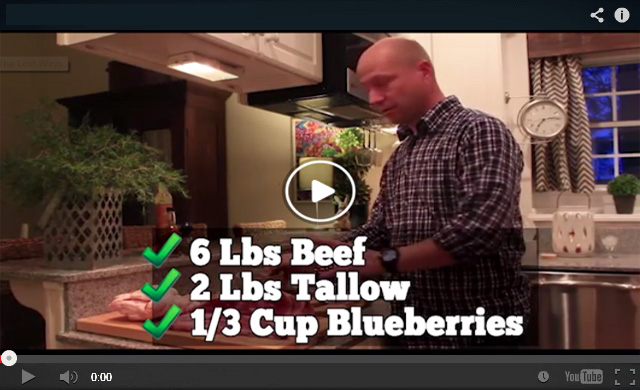

As far as long term storage wouldn’t the fat become rancid? What’s the shelf life? Probably sealing in vacuum bags would be the long term solution.
iIs it possible to use ground beef in pemmican?
Sure bob. Ground beef is perfect.
Can you substitute the lard for a vegetable lard or coconut oil?
I have been looking for a dried blueberries and cranberries, everything in the store that says it’s dried it seems to be somewhat sticky and doesn’t seem to be completely dried out like it says on the package. Are these OK to use?
Terry, if the berries are not completely dry just set them on a newspaper or a piece of paper in direct sunlight. They will dry more.